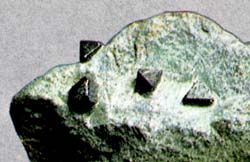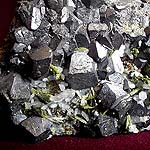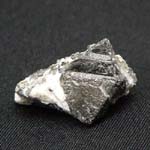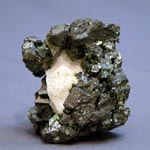Spinels (oxides): Magnetite
 Diagnostic card.
Diagnostic card.
On the picture. Octahedral crystals of magnetite. Below: a demonstration of the magnetic attraction of a sample of magnetite Elba Island.
Fe 3 O 4
Cubic cubic system
Hardness 6-6,5
Specific weight 5.2
Cleavage is absent
Crack irregular
Black color
Color in powder black
Glitter metal

 Magnetite (magnetic iron ore) is iron oxide. The gloss is metallic, opaque. Black color. The line is black. Fracture shell. It's fragile. Cleavage is imperfect. Magnetene. Crystals (cubic syngony) are usually represented by octahedra. Aggregates are dense, drained or granular.
Magnetite (magnetic iron ore) is iron oxide. The gloss is metallic, opaque. Black color. The line is black. Fracture shell. It's fragile. Cleavage is imperfect. Magnetene. Crystals (cubic syngony) are usually represented by octahedra. Aggregates are dense, drained or granular.
Magnetite ores are genetically associated with metamorphic or magmatic rocks, as well as with skarns, sometimes in hydrothermal veins. Less often, magnetite accumulates in placers (magnetite sands). Magnetite ores have the highest iron content and are easily enriched by magnetic separation. Deposits: in Sweden, Norway, the CIS (Kola Peninsula, Karelia, the Urals), the USA, Brazil, Venezuela, India.
Magnetite, or magnetic iron ore, is iron oxide. Crystals (cubic syngony) are usually well formed and have a specific appearance: mainly octahedra, less often dodecahedrons. It is often found in the form of solid masses or fine aggregates, forming large clusters. It occurs in the Alps, on about. Elbe, in Sweden, the USA: in the CIS - on the Kola Peninsula, the Urals. Magnetite ores are the most valuable of iron ores.
 This is the most iron-rich mineral. Crystallized in cubic syngony in the form of octahedra and rhombododecahedrons of perfect form; Faces with hatching; Crystals are shiny, black in color. However, usually magnetite is found in the form of dense or granular masses of iron-black color, with a bluish tinge. The gloss is metallic, the mineral is opaque in light. In powder - black. Brittle, cleavage is not observed, very heavy. Quite hard, even the point of the knife scratches with difficulty.
This is the most iron-rich mineral. Crystallized in cubic syngony in the form of octahedra and rhombododecahedrons of perfect form; Faces with hatching; Crystals are shiny, black in color. However, usually magnetite is found in the form of dense or granular masses of iron-black color, with a bluish tinge. The gloss is metallic, the mineral is opaque in light. In powder - black. Brittle, cleavage is not observed, very heavy. Quite hard, even the point of the knife scratches with difficulty.
Chemical composition-content (in%): FeO-31; Fe2O3 - 69; Typical impurities are titanium, chromium, magnesium, manganese, nickel, vanadium, aluminum. Hexaoctahedral symmetry. Cleavage is absent. It occurs in fine-grained solid masses, inclusions, and also in the form of crystals of the octahedral, less often rhombododecahedral habit with simple forms (100), (111), (110), (211), (210) and characteristic diagonal shading on the faces (110). Spherolites, kidney aggregates, pseudomorphs of magnetite in hematite (musketovite), chrysotile-asbestos, perovskite and other minerals are also known.
Diagnostic signs.
Magnetite is extremely magnetic. Attracts the magnetic needle, in addition, has the property of magnetic polarity and attracts objects from iron. Can serve as a natural magnet. Weathering is difficult.
Origin.
Magnetite is dispersed in all rocks. Typical for him nevertheless segregation-magmatic genesis, characteristic for femic and ultraphemic rocks, rich in iron and magnesium. Hydrothermal origin, that is, crystallization from residual fluids (magmatic gases), is quite common during the formation of rocks such as granites and pegmatites. Large amounts of magnetite accumulate also in sedimentary conditions, mainly in sands formed by the destruction of primary rocks containing this mineral. Since magnetite is heavy and resistant to weathering, it is easily concentrated in placers. In addition, the mineral is distributed in skarns formed on the contact of the array of pluton with surrounding rocks.
Place of Birth.
Among the deposits of segregation-magmatic origin, the largest industrial importance is Kiruna in Sweden. Magnetite is associated here with iron silicates, so that in the metallurgical process, steel is obtained, naturally alloyed with silica. It has a high hardness and is therefore highly valued. Large deposits are also open in South Africa, the United States (Iron Springs, Iron Mountain), Russia (in the Urals). In Magnet Cove (USA), natural magnetic ore is being developed. Beautiful crystals originate from Valle di Binn (Switzerland) and from Val Malenko (Sondrio province), where they occur together with asbestos. Presented also in Ukraine, where it is developed as iron ore.
Application.
Magnetite is used in ferrous metallurgy to produce special steels. In some cases vanadium and phosphorus can be extracted from its slag.





Magnetite from metakimberlita. Successful pipe, Yakutia, Russia. Photo: © А.А. Evseev.
- Ghetchellit - "New Almaden blend" - arsenide and antimony sulfide (modern sulfosol)
- Antimony is a toxic metal (semimetal) , widely used in metallurgy, medicine and engineering
- Zirconium - a rare and undiscovered metal and the most dangerous precious stone in oxide and salt
- Gold - yellow dangerous and poisonous metal of modern accurate digital and cable technologies
- Sulfur is a golden-yellow toxic substance and a sign of active volcanic activity
- Cadmium is an undisputed toxic silvery metal unknown to a wide range of people
- Lead - a poisonous gray imitator of metallic silver and toxic metal blende
- Arsenic is a classic poison of medieval and modern poisoners and medicine in medicine
Poisonous and radioactive dangerous stones and minerals
** - poisonous stones and minerals (mandatory check in the chemical laboratory + explicit indication of toxicity)
** - radioactive stones and minerals (mandatory check on the standard dosimeter + ban on open sales in case of radioactivity exceeding 24 milli / g / h + additional measures of population protection)
Catalog of minerals and semi-precious stones of the world by groups
** - poisonous stones and minerals
** - radioactive stones and minerals


Comments
When commenting on, remember that the content and tone of your message can hurt the feelings of real people, show respect and tolerance to your interlocutors even if you do not share their opinion, your behavior in the conditions of freedom of expression and anonymity provided by the Internet, changes Not only virtual, but also the real world. All comments are hidden from the index, spam is controlled.